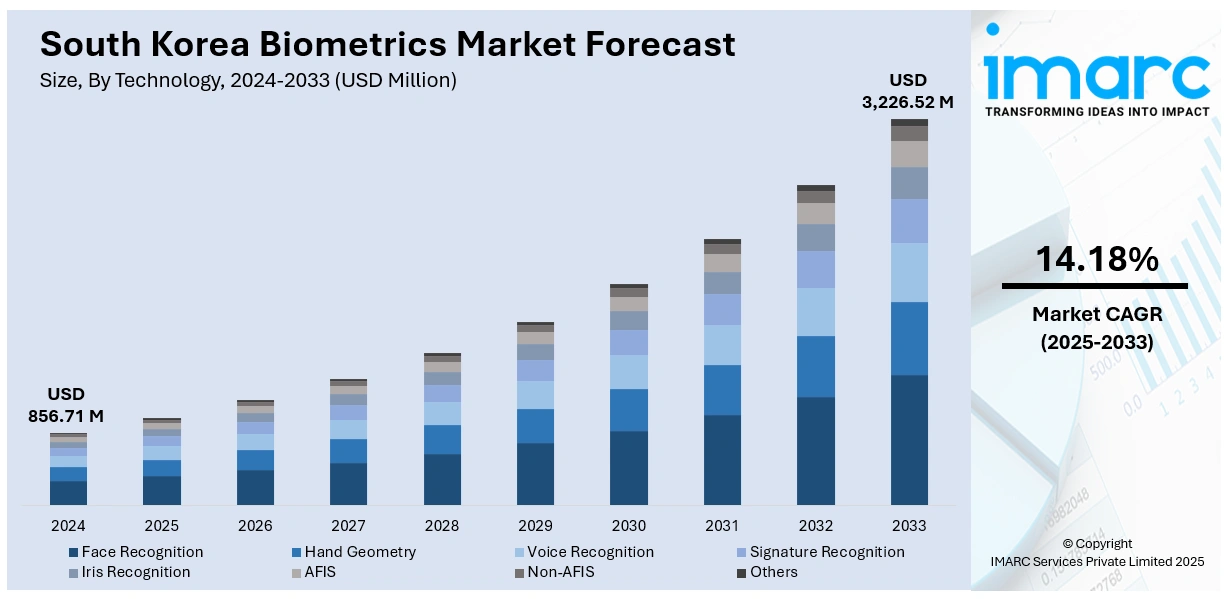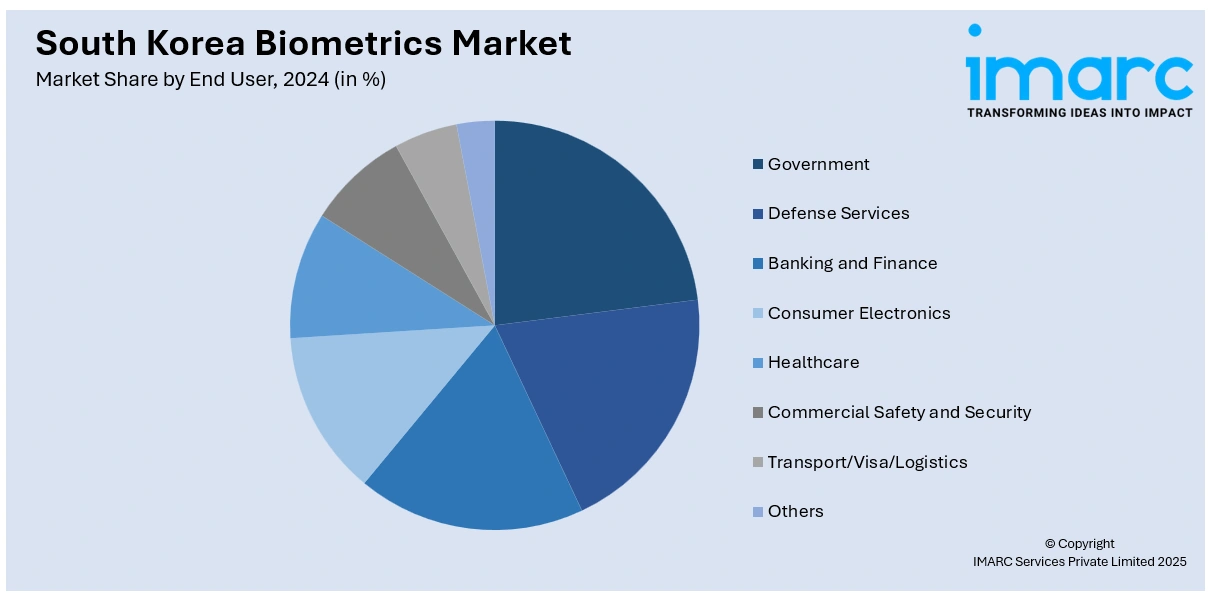
South Korea Biometrics Market Size, Share, Trends and Forecast by Technology, Functionality, Component, Authentication, End User, and Region, 2025-2033
South Korea Biometrics Market Overview:
The South Korea biometrics market size reached USD 856.71 Million in 2024. Looking forward, the market is projected to reach USD 3,226.52 Million by 2033, exhibiting a growth rate (CAGR) of 14.18% during 2025-2033. The market is witnessing steady growth driven by rising demand for secure authentication in banking, government services, and consumer electronics. Increasing adoption of fingerprint, facial, and iris recognition technologies in smartphones and smart devices is also fueling market expansion. Growing emphasis on cybersecurity, digital identity verification, and public safety initiatives, along with technological advancements and investments in AI-based solutions, further strengthen South Korea biometrics market share.
|
Report Attribute
|
Key Statistics
|
|---|---|
|
Base Year
|
2024
|
|
Forecast Years
|
2025-2033
|
|
Historical Years
|
2019-2024
|
| Market Size in 2024 | USD 856.71 Million |
| Market Forecast in 2033 | USD 3,226.52 Million |
| Market Growth Rate 2025-2033 | 14.18% |
South Korea Biometrics Market Trends:
Contactless Authentication Growth
The need for contactless authentication is rapidly increasing in South Korea, transforming the biometrics sector with innovative facial and iris recognition technologies. In the wake of the pandemic, both consumers and businesses have become more mindful of hygiene and physical contact, prompting a shift towards touchless identity verification approaches. This movement is particularly noticeable in industries like airports, public transport, healthcare, finance, and retail, where there is significant user interaction and a need for secure yet hygienic methods. For instance, in May 2025, Korean startup WINNING.I launched the world's first contactless biometric authentication solution, enabling simultaneous facial and fingerprint recognition using a smartphone's front and rear cameras. The technology has received iBeta certification for 100% spoof prevention, enhancing identity verification for financial services and other sectors while attracting global market interest. Contactless biometric solutions not only minimize the risk of infection but also improve speed and convenience, making them suitable for extensive applications such as border control and digital transactions. The incorporation of artificial intelligence and cloud technology is enhancing accuracy, scalability, and the ability for real-time authentication. As organizations put greater emphasis on security and improving customer experience, the rising use of touchless technologies is expected to significantly boost the biometrics market in South Korea in the coming years.

To get more information on this market, Request Sample
Expansion in Financial Services
The financial services sector is emerging as a significant catalyst for the South Korea biometrics market growth, as banks and fintech firms increasingly implement biometric authentication to enhance security and improve customer experience. With the growth of mobile banking and digital payment platforms, conventional passwords and PINs are being substituted with fingerprint, facial, and voice recognition systems that offer quicker and more dependable identity verification. This transition addresses rising concerns about cyber fraud, data breaches, and unauthorized transactions, ensuring convenience and safety for users. Additionally, regulatory organizations are promoting stronger authentication frameworks, urging financial institutions to invest in cutting-edge biometric solutions. For instance, in July 2025, Lotte Card received approval from South Korea’s Financial Services Commission for its facial recognition payment system, allowing trials at select airports and duty-free stores. This innovative service enables transactions via facial scans, complying with strict data protection regulations and paving the way for broader biometric payment adoption in the country. Contactless verification methods are also gaining popularity, aligning with consumer preferences for smooth digital interactions. As financial services broaden their digital offerings, biometrics play a crucial role in shaping secure, efficient, and trusted banking ecosystems in South Korea.
South Korea Biometrics Market Segmentation:
IMARC Group provides an analysis of the key trends in each segment of the market, along with forecasts at the country and regional levels for 2025-2033. Our report has categorized the market based on technology, functionality, component, authentication, and end user.
Technology Insights:
- Face Recognition
- Hand Geometry
- Voice Recognition
- Signature Recognition
- Iris Recognition
- AFIS
- Non-AFIS
- Others
The report has provided a detailed breakup and analysis of the market based on technology. This includes face recognition, hand geometry, voice recognition, signature recognition, iris recognition, AFIS, non-AFIS, and others.
Functionality Insights:
- Contact
- Non-contact
- Combined
A detailed breakup and analysis of the market based on the functionality have also been provided in the report. This includes contact, non-contact, and combined.
Component Insights:
- Hardware
- Software
The report has provided a detailed breakup and analysis of the market based on the component. This includes hardware and software.
Authentication Insights:
- Single-Factor Authentication
- Multifactor Authentication
A detailed breakup and analysis of the market based on the authentication has also been provided in the report. This includes single-factor authentication and multifactor authentication.
End User Insights:

- Government
- Defense Services
- Banking and Finance
- Consumer Electronics
- Healthcare
- Commercial Safety and Security
- Transport/Visa/Logistics
- Others
A detailed breakup and analysis of the market based on the end user has also been provided in the report. This includes government, defense services, banking and finance, consumer electronics, healthcare, commercial safety and security, transport/visa/logistics, and others.
Regional Insights:
- Seoul Capital Area
- Yeongnam (Southeastern Region)
- Honam (Southwestern Region)
- Hoseo (Central Region)
- Others
The report has also provided a comprehensive analysis of all the major regional markets, which include Seoul Capital Area, Yeongnam (Southeastern Region), Honam (Southwestern Region), Hoseo (Central Region), and others.
Competitive Landscape:
The market research report has also provided a comprehensive analysis of the competitive landscape. Competitive analysis such as market structure, key player positioning, top winning strategies, competitive dashboard, and company evaluation quadrant has been covered in the report. Also, detailed profiles of all major companies have been provided.
South Korea Biometrics Market News:
- In July 2025, KT, South Korea’s largest telecommunications company, partnered with the Military Personnel Mutual Aid Association C&C to create a cloud-based biometric platform for the “Nara Sarang Card.” This modernization aims to streamline military ID issuance and enhance security through facial and fingerprint recognition, with project completion expected by late 2025.
- In February 2025, Toss FacePay, a biometric payment system utilizing facial recognition, was launched in convenience stores across South Korea, enhancing both security and convenience. Developed by the fintech company Toss, this system enables cashless transactions and streamlines the payment process.
- In November 2024, IDEX Biometrics partnered with South Korean firm Cellfie Global to develop and market biometric metal and PVC cards for banking and fintech sectors across the USA, Europe, and Asia. This collaboration enhances IDEX's access to significant production capacity and taps into Cellfie's established customer base in key markets.
South Korea Biometrics Market Report Coverage:
| Report Features | Details |
|---|---|
| Base Year of the Analysis | 2024 |
| Historical Period | 2019-2024 |
| Forecast Period | 2025-2033 |
| Units | Million USD |
| Scope of the Report |
Exploration of Historical Trends and Market Outlook, Industry Catalysts and Challenges, Segment-Wise Historical and Future Market Assessment:
|
| Technologies Covered | Face Recognition, Hand Geometry, Voice Recognition, Signature Recognition, Iris Recognition, AFIS, Non-AFIS, Others |
| Functionalities Covered | Contact, Non-contact, Combined |
| Components Covered | Hardware, Software |
| Authentications Covered | Single-Factor Authentication, Multifactor Authentication |
| End Users Covered | Government, Defense Services, Banking and Finance, Consumer Electronics, Healthcare, Commercial Safety and Security, Transport/Visa/Logistics, Others |
| Regions Covered | Seoul Capital Area, Yeongnam (Southeastern Region), Honam (Southwestern Region), Hoseo (Central Region), Others |
| Customization Scope | 10% Free Customization |
| Post-Sale Analyst Support | 10-12 Weeks |
| Delivery Format | PDF and Excel through Email (We can also provide the editable version of the report in PPT/Word format on special request) |
Key Questions Answered in This Report:
- How has the South Korea biometrics market performed so far and how will it perform in the coming years?
- What is the breakup of the South Korea biometrics market on the basis of technology?
- What is the breakup of the South Korea biometrics market on the basis of functionality?
- What is the breakup of the South Korea biometrics market on the basis of component?
- What is the breakup of the South Korea biometrics market on the basis of authentication?
- What is the breakup of the South Korea biometrics market on the basis of end user?
- What is the breakup of the South Korea biometrics market on the basis of region?
- What are the various stages in the value chain of the South Korea biometrics market?
- What are the key driving factors and challenges in the South Korea biometrics market?
- What is the structure of the South Korea biometrics market and who are the key players?
- What is the degree of competition in the South Korea biometrics market?
Key Benefits for Stakeholders:
- IMARC’s industry report offers a comprehensive quantitative analysis of various market segments, historical and current market trends, market forecasts, and dynamics of the South Korea biometrics market from 2019-2033.
- The research report provides the latest information on the market drivers, challenges, and opportunities in the South Korea biometrics market.
- Porter's five forces analysis assist stakeholders in assessing the impact of new entrants, competitive rivalry, supplier power, buyer power, and the threat of substitution. It helps stakeholders to analyze the level of competition within the South Korea biometrics industry and its attractiveness.
- Competitive landscape allows stakeholders to understand their competitive environment and provides an insight into the current positions of key players in the market.
Need more help?
- Speak to our experienced analysts for insights on the current market scenarios.
- Include additional segments and countries to customize the report as per your requirement.
- Gain an unparalleled competitive advantage in your domain by understanding how to utilize the report and positively impacting your operations and revenue.
- For further assistance, please connect with our analysts.
 Request Customization
Request Customization
 Speak to an Analyst
Speak to an Analyst
 Request Brochure
Request Brochure
 Inquire Before Buying
Inquire Before Buying




.webp)




.webp)












